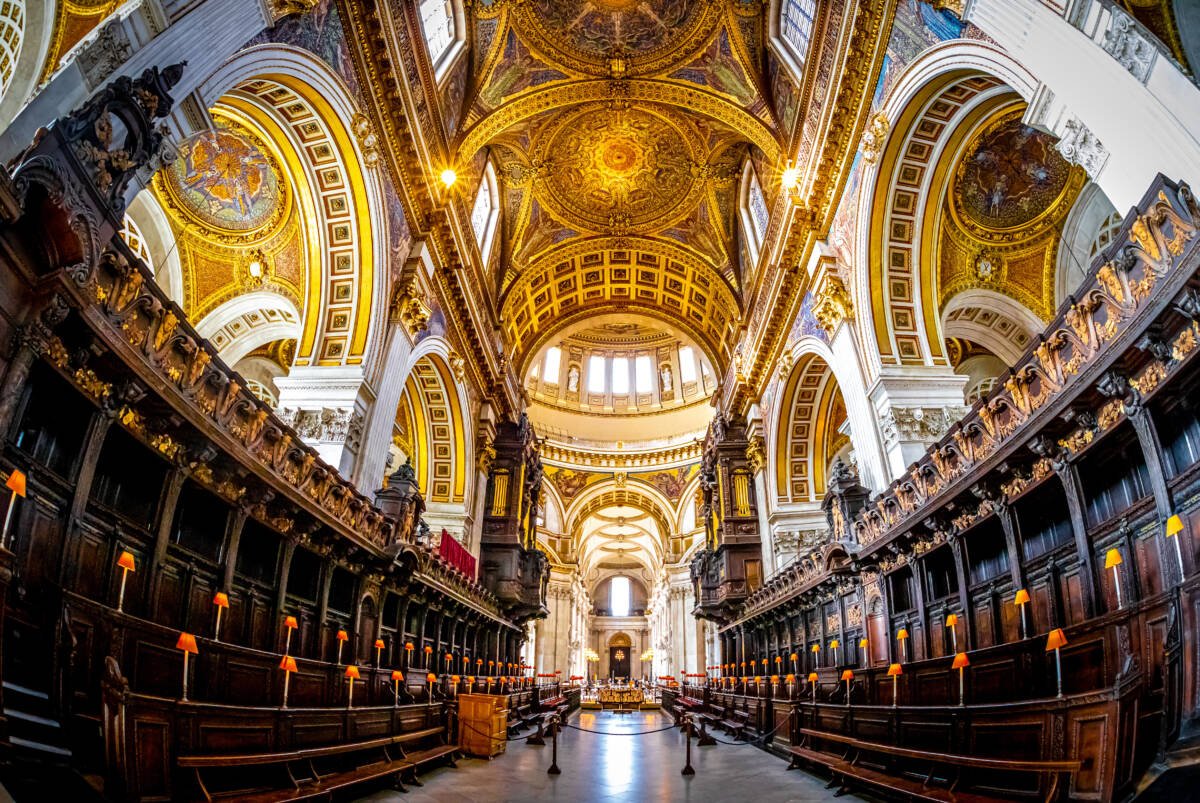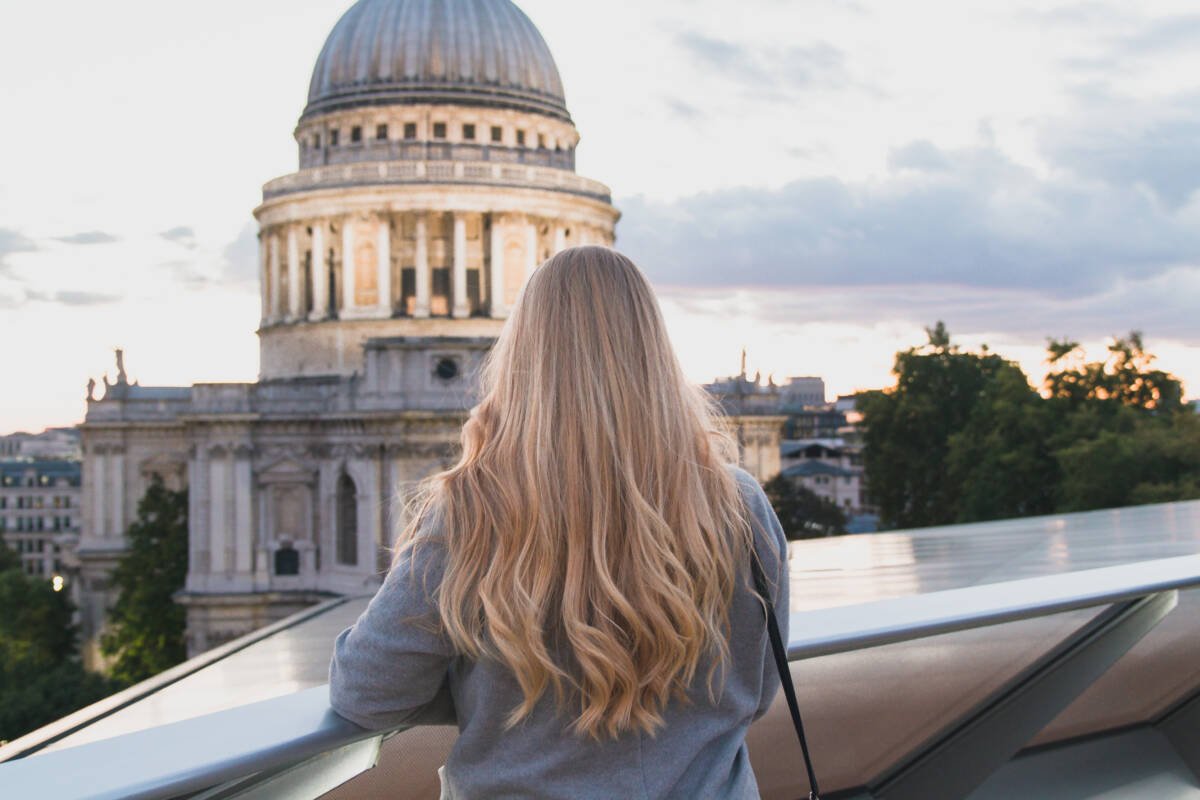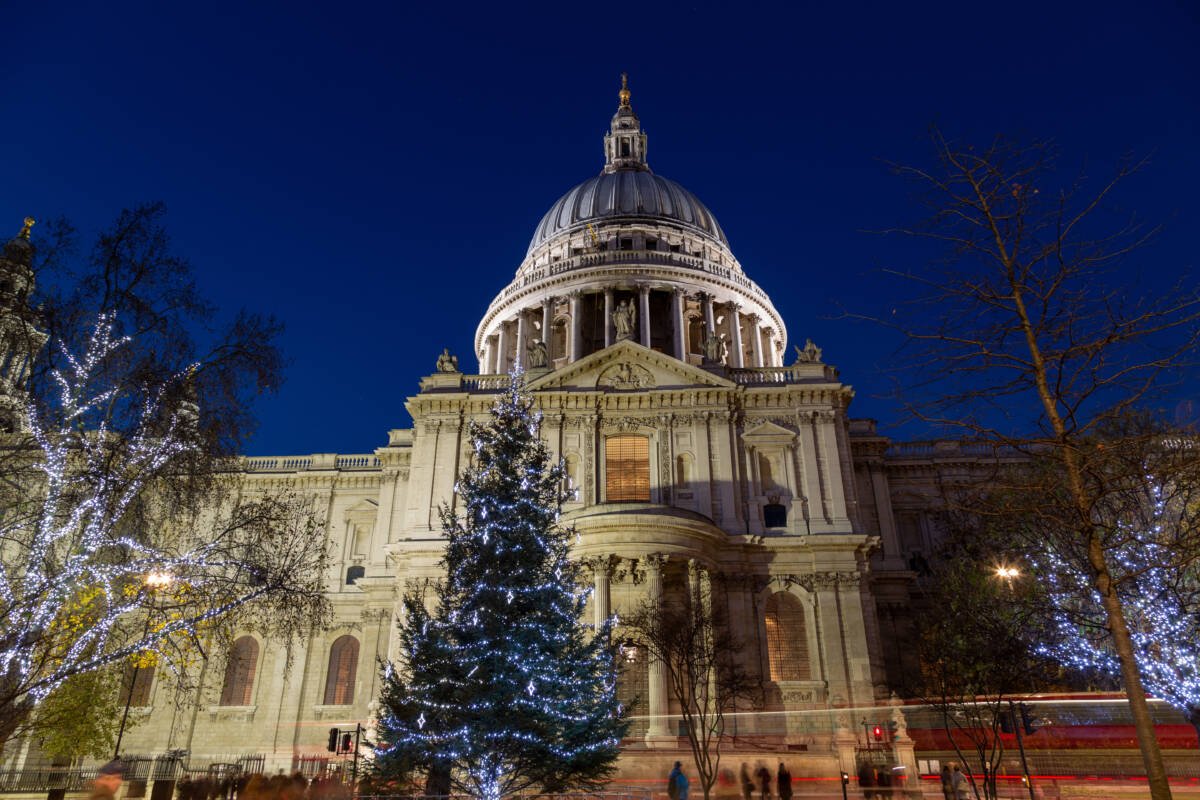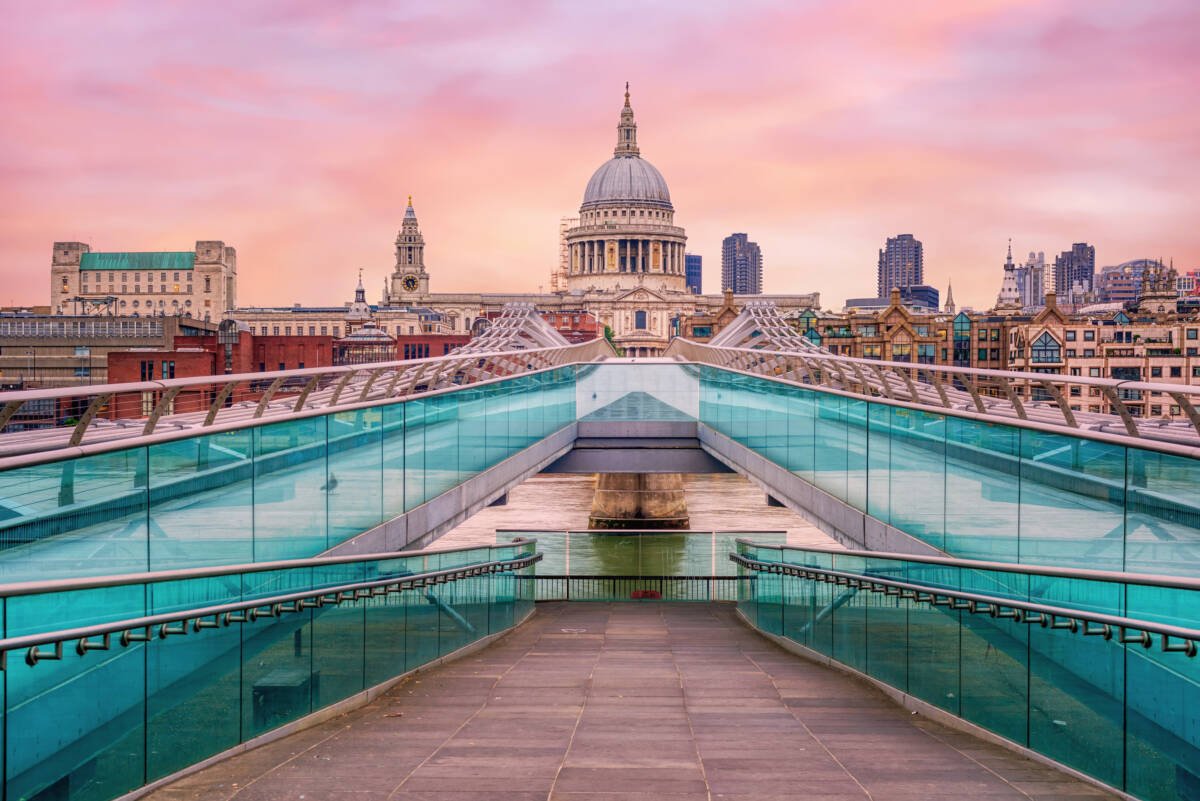St Pauls Cathedral London is one of the most famous landmarks in London. Standing on Ludgate Hill, its majestic dome is visible from many parts of the city.
It’s a symbol of London’s strength and resilience and has been the site of many historic occasions, including royal weddings and state funerals. Besides being a working church and a place for quiet reflection, there are many wonderful things to see inside during your visit.
In this post, we will give you an overview of the history of the cathedral and tell you what you will see inside. We will also give you tips for visiting and climbing the magnificent dome.
Join our St Pauls Cathedral tours in the company of an expert guide and understand why it’s one of the most popular historical places to visit in London.
History of St Paul’s Cathedral
The history of St Pauls Cathedral London is truly fascinating, as at this site at least four churches have been built. The first church was built by King Erkenwald back in 604 AD and was dedicated to St. Paul. It was a simple wooden church but unfortunately it was destroyed by fire. The early versions of St. Paul’s Cathedral never lasted very long as they were either destroyed by fire or Viking attacks.
Finally in 1087, Bishop Maurice went on to build a cathedral that would last for almost 600 years. This structure is often referred to as the Old St. Paul’s Cathedral and during its lifetime it went on to be the centre of religious life in London.
Sadly, once again this cathedral too perished in a fire during the Great Fire of London in 1666. This was a massive fire that destroyed 80 percent of London. This included 89 churches and 13,200 houses.
But there was hope and the history of St. Paul’s Cathedral did not end here, Christopher Wren, a famous architect was assigned the task of completely rebuilding the cathedral.
He created three different designs. The first design was considered too modest. The second design was known as ‘the Great Model’. It was a grand project with a massive dome and Corinthian columns. But this was also rejected as it was considered unfit for large processions. Largely, the current version of St. Paul’s Cathedral was built between 1675 and 1711 and was considered a great feat during that time.
Thereafter, the history of St. Paul’s Cathedral has been closely linked to the history of London. It has hosted many important historical events such as the peace services that marked the end of both world wars, the funerals of Winston Churchill and Margaret Thatcher, the wedding of Prince Charles and Princess Diana, the 80th and 90th birthdays of Queen Elizabeth II, and much more.
St Paul’s Cathedral Inside

St Pauls Cathedral London is home to a variety of art and includes sculptures by one of England’s most skilful woodcarvers – Grinling Gibbons and incredible frescoes in its dome.
Such is the magic of the cathedral that it has inspired many contemporary artists such as Bill Viola, Antony Gormley, Rebecca Horn, Yoko Ono and many more.
The Cathedral is planned on three levels: the crypt (in the basement), the ground floor and the galleries (at a height).
Nave
As you step inside, the first thing you’ll see is the grand nave. This is the central corridor and the most spacious part of the cathedral that leads to the impressive dome. The west end of the nave is dominated by the Great West Doors and their use is reserved for special occasions such as the visit of Queen Elizabeth II or the Mayor of London. Otherwise, the nave is scattered with many monuments and sculptures, the most spectacular monument is the Duke of Wellington memorial in the central bay. The nave has been designed in dual nature, a part in classic architectural ornamentation, while its character changes from the dome up to the apse.
The Dome and its three domes

St Pauls Cathedral London dome stands 111.3 meters tall (365 feet – one for each day of the year) and weighs 65,000 tonnes, it’s the second tallest dome in Europe after that of St. Peter’s Basilica in Rome that stands at 120 meters high.
This massive dome is made up of three circular galleries which take the form of balconies and are one of the main features of the cathedral.
As you climb the first 257 steps, you will arrive at the mythical – Whispering Gallery. It’s a circular room decorated with mosaics, colourful frescoes and has impressive acoustics. The slightest whisper can be heard from one end of the gallery to the other. From here the bird’s eye view of the choir is also impressive.
As you climb 119 steps higher, at a height of 52 meters, you will discover – The Stone Gallery which offers striking first views of the city. Finally, as you climb 152 steps higher, you will enter – The Golden Gallery, at the top of the dome. At more than 85 meters high – this is the highest point of St Paul’s Cathedral and offers breath-taking panoramic views of London. The paintings on the dome represent the eight scenes from the life of Saint-Paul.
The Quire (Choir)
The choir was the first part to be built and is the most sacred space of the cathedral. Created by the Dutch sculptor Grinling Gibbons, on both sides are exquisitely carved wooden stalls with canopies. While the quire bays and aisles have hundreds of mosaics that depict the narrative scenes from the Old Testament. Even today, it’s still used for its original purpose – where the choir, clergy, and people sit for Evensong. While one space is reserved for the Bishop of London.
High Altar
The current high altar of St. Paul’s Cathedral is a replacement to the old Victorian-style marble altar that was damaged during the Second World War. It’s a beautifully carved slab of Italian marble and was designed from the original sketches by Wren. Atop the High Altar stands a 10-feet large cross, and is flanked by two gilded candlesticks, each five feet tall. The Altar is covered by a large oak canopy that was installed in 1958.
Grand Organ
As you walk towards the High Altar, you’ll see a Grand Organ standing and its case made by Grinling Gibbons. Installed in 1695, the organ is one of the most important elements of St Paul’s Cathedral. It has 7189 tubes, 5 keyboards of 138 keys each, and is the largest organ in the United Kingdom.
The North Transept
One of the famous paintings in St Paul’s is located at the cathedral’s north transept. It’s called “The Light of the World” by William Holman Hunt and is placed within the chapel of Saint Erkenwald and Saint Ethelburga. The painting depicts Jesus Christ knocking on a door from within, suggesting the idea that God can only enter our lives if we invite him to do so. The painting dates from the 1900s and in the early 20th century it was taken on a tour, and was seen by over two million people.
The South Transept
It’s in the South transept where you’ll see the monument of the great naval hero of Great Britain – Horatio Nelson (Lord Nelson or Admiral Nelson). He died during the Battle of Trafalgar, in 1805. Other monuments within this space pay homage to – J.M.W Turner (famous painter), Cuthbert Collingwood (British naval officer) and Robert Scott (famous explorer).
Crypt
As you exit the cathedral, you’ll go down into the crypt. This is the largest crypt in Europe, where some of Britain’s most significant figures are buried, including Arthur Wellesley, Duke of Wellington and Lord Nelson. It’s also the final resting place of many other famous people, from artists to military heroes. In 2010, the St. Paul’s Oculus was opened in the crypt. Three short 270-degree films are shown here that tell the 1,400-year history of St Paul’s Cathedral: Life of the Cathedral; Resurgam, I will Rise Again; and Virtual Access, the Dome. The crypt also has a café and a space where you can enjoy your afternoon tea.
The Chapels
What makes a visit to St Paul’s Cathedral so unique is its chapels. They offer a place for reflection, prayer and smaller services. There are seven of them and each has its own history and significance. They are the Chapel of All Souls, Chapel of St Dunstan, Chapel of St Michael and St George, the Middlesex Chapel, American Memorial Chapel, the Knights Bachelor Chapel and the Order of the British Empire Chapel.
Triforium Tour
Like every major cathedral in Europe, St. Paul’s also has a Triforium. This gallery is located above the arches of the nave and is usually closed off to the public. It’s open to the public on specific days of the year.
Usually, these galleries are used to store extra artifacts. But St. Paul’s has its own secret treasures inside the Triforium such as the library, the Geometric Staircase, the Great Model, and much more. The tour also features a great view down the nave from over the Great West Doors.
You can book a private Triforium tour with Rosotravel for a party of at least 5 people, with a maximum of 20 guests allowed admission.
Further, St Paul’s Cathedral also boasts of stunning exteriors.
The West Facade
The impressive facade at the western side of the church consists of a large portico and pediment. The triangular relief depicts the conversion of Paul to Christianity and was created in 1706. The portico is surrounded by two towers which weren’t part of the original plan, but were added by Wren at the last minute, in 1707.
The Two Towers
The two western towers are topped with a pineapple – a symbol of peace, prosperity and hospitality. On the southwest tower is a clock which was installed in 1893 and has three faces. Above the clock hangs the Great Tom, the hour bell, and Great Paul, and the largest swinging bell in Europe.
The South Churchyard
This is the space around St Paul’s Cathedral. It was renovated in 2008 with a floor-plan of the Old St Paul’s Cathedral that existed before it burned down in the Great Fire. This floor plan can be seen at the western end of the courtyard, along with a superimposed outline of the current building.
Chapter House
This is the administrative centre of St. Paul’s Cathedral. It’s an elegant brick building that faces the newly developed Paternoster Square.
St Paul’s Cross
As you walk along the courtyard, you’ll see an impressive column that contains a gilded pillar of St Paul. During the 16th and 17th centuries many important statements on political and religious changes were made public from this place. Today, this column of St Paul stands as a remembrance of the public preaching of Christianity that once took place here.
Souvenir Shop
There is a souvenir shop within the St Paul’s Cathedral which is only accessible to visitors. It offers various products on the theme of the cathedral such as books, music, paintings, decorative objects, etc.
Visitors Information
- St Pauls Cathedral London is open for sightseeing from 8:30 am to 4:30 pm on Monday, Tuesday, Thursday, Friday and Saturday. On Wednesday, it’s open from 10:00 am to 4:30 pm.
- Last entry for sightseeing is 4:00 pm.
- On Sundays and religious holidays such as Easter and Christmas, the Cathedral is open for worship only.
- If you like choral music and singing you should visit the mass – Choral Evensong. This mass usually takes place from Monday to Saturday at 5:00 pm and on Sunday’s at 3:00 pm. It lasts about 45 minutes and the entry is free.
Tips before visiting the Cathedral

- Visit the Cathedral during the early opening hours so that you can enjoy the solemn and peaceful Cathedral in all its glory.
- The recommended visiting time here is approximately two hours, so plan accordingly.
- Dress modestly before entering the Cathedral.
- Large bags or luggage are not allowed, and all hand-bags will be searched by security personnel.
- Visitors are allowed to take photographs of the main cathedral floor, the crypt and the galleries. However, videos and selfie sticks are not permitted anywhere in the church.
- There is a cafe and restaurant on the lower floor of the cathedral.
- There are toilet facilities down in the crypt that is accessible from both inside and outside the Church.
Disabled Access
- Cathedral wheelchairs are available on request.
- Wheelchair users and visitors with mobility issues should enter via the South Churchyard. This entrance leads to a modern lift serving the crypt and cathedral floor.
- The Crypt level has permanent ramps so is fully accessible (Crypt, shop and cafe and toilets).
- On the Cathedral Floor, the only inaccessible area is the American Chapel.
- Guide dogs, hearing dogs and assistance dogs are welcome in the Cathedral at all times.
Private Guided Tours with Rosotravel

St Pauls Cathedral London is a popular tourist attraction; hence we advise you to book your tickets well in advance. This can be done by booking our skip-the-line St Pauls Cathedral tours in the language of your choice. We offer tours in 6-9 languages.
You can also customize this private tour and see some of St. Paul’s secret spots (like the triforium and spiral staircase) that are generally not part of a standard tour.
Booking a private tour has its own advantages as you will be accompanied by an expert guide who will tell you everything about the cathedral including their own set of stories and secrets about the cathedral. And once you’re done touring the cathedral, you can actually climb to the top for some pretty awesome views of London.
Trivia: St Pauls Cathedral London was a filming location for the Harry Potter movie ‘Prisoner of Azkaban’. If you’re a Potter fan, you can book a guided Harry Potter tour too.
Christmas at St Paul’s Cathedral
Christmas in London can be a magical experience. Although the weather is cold and wet, there’s a certain charm to the English capital during the festive season.
The shops are decorated and there are a number of special events going throughout the city. If you’re visiting London during Christmas, there is no better place to celebrate it in the spiritual surrounding of St Paul’s. The cathedral has a number of services throughout Christmas to celebrate the birth of Jesus. Beginning with carols to midnight mass, St Paul’s provides a truly authentic Christmas experience. Throughout the month of December there are a number of concerts leading up to the big day.
Further, the days around Christmas are truly special, and also very popular. On the 23rd and Christmas Eve there are special Christmas carol services before the Midnight Eucharist, the Communion is served outside of the cathedral. You can either queue up to experience the service in the cathedral, or view it on a big screen nearby at Paternoster Square. It’s a magical experience when the great dome is filled with the sounds of Christmas carols.
So that’s a glimpse of what you will see and learn during your visit to St Pauls Cathedral London. If you’re visiting London, we highly recommend visiting the cathedral as its one of the most incredible cathedrals you’ve ever seen.
It provides a relaxing break away from the busy streets of London and allows you to embrace your spiritual side. A stroll around the cathedral also gives you a glimpse of London’s past and present.

If you’ve enjoyed reading this post, we’re sure you’d love to join one of our private St Pauls Cathedral Tours, led by an expert guide.
Please feel free to get in touch if you have any questions about visiting St. Paul’s Cathedral – one of the most famous historical places to visit in London.


